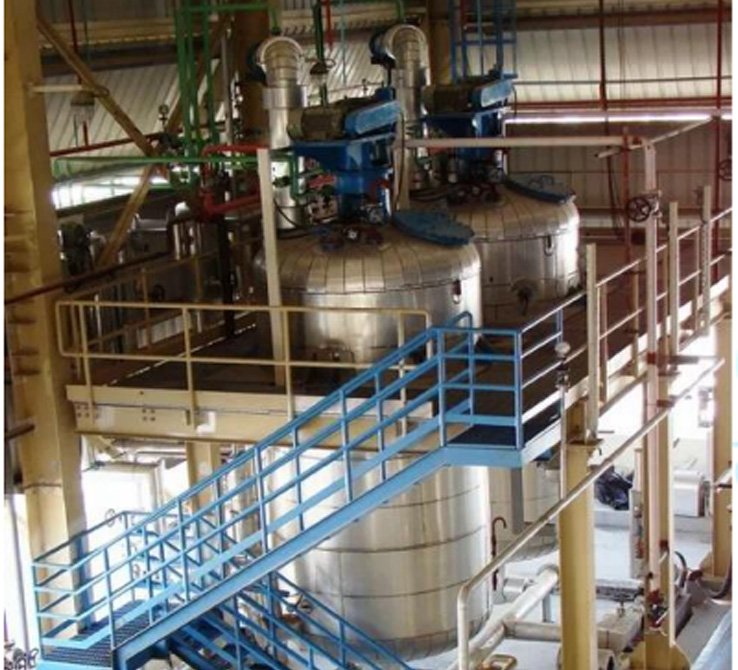- Home
- About Us
- Process Equipment
- Turnkey Solutions
- Evaporators
- Water Division
- Pilot Plant
- Services
- Clients
- Career
- Contact Us





A solvent recovery plant is designed to reclaim and purify solvents from waste streams, reducing the need for fresh solvents and minimizing environmental impact. This process is essential in industries such as pharmaceuticals, chemicals, and coatings, where solvents are frequently used and can be expensive to dispose of or replace.
1. Collection of Waste Solvent:
2. Separation:
3. Distillation:
4. Condensation:
5. Storage and Reuse:
1. Feed Tank:
2. Distillation Column:
3. Reboiler: Heats the waste solvent mixture, causing the solvent to vaporize and rise through the distillation column.
4. Condenser: Cools the vaporized solvent, turning it back into a liquid.
5. Reflux Drum:
Collects the condensed solvent. A portion of this solvent may be returned to the column as reflux to improve separation efficiency, while the remainder is collected as the purified solvent.6. Filtration Units:Removes solid impurities from the waste solvent mixture before distillation.
7. Adsorption Columns: May be used to remove specific impurities such as water or certain chemicals through adsorption.
8. Storage Tanks: Store the recovered solvent before it is reused or further processed.
9. Pumps: Used to move the solvent through the various stages of the process.
10. Control Systems: Automated systems to monitor and control temperature, pressure, and flow rates within the solvent recovery process.
Here’s a basic outline of the solvent recovery process:
1. Waste Solvent Collection: The waste solvent mixture is collected and stored in feed tanks.
2. Pre-Treatment:
3. Distillation:
4. Condensation: The vaporized solvent is condensed back into a liquid by the condenser.
5. Reflux: Part of the condensed solvent may be returned to the distillation column to enhance separation.
6. Storage: The recovered, purified solvent is stored in tanks for reuse.




A Biodiesel Production Plant is designed to produce biodiesel, a renewable and environmentally friendly alternative to traditional petroleum-based diesel. Biodiesel is made from various feedstocks such as vegetable oils, animal fats, and recycled cooking oils through a chemical process called transesterification. This process converts the fats and oils into fatty acid methyl esters (FAME), commonly known as biodiesel, and glycerol as a byproduct.
1. Collection of Waste Solvent:
1. Feedstock Preparation:
2. Transesterification Reactor:
3. Separation Units:
4. Washing and Drying Systems:
5. Methanol Recovery System:
6. Glycerol Purification:
1. Feedstock Preparation:
2. Transesterification:
3. Separation:
4. Washing:
5. Methanol Recovery:
6. Glycerol Purification:






An Ethyl acetate production plant is designed to generate ethyl acetate, an important organic solvent, through various chemical processes, primarily esterification. This report presents a detailed overview of the plant, encompassing the production processes, key equipment utilized, operational parameters, and applications of ethyl acetate. Ethyl acetate is an organic compound categorized as an ester, mainly used as a solvent in paints, coatings, adhesives, and food flavorings. It is produced by the esterification of ethanol with acetic acid. The choice of feedstocks, reaction conditions, and methods are critical to achieving high yields and efficiency.
The main raw materials required for the production of ethyl acetate include:
The primary reaction for producing ethyl acetate involves esterification, which can occur through different pathways.
The direct esterification process involves the chemical reaction of acetic acid with ethanol in the presence of an acid catalyst, typically a strong acid like sulfuric acid or an acidic ion-exchange resin (such as Amberlyst-15).
1. Reaction Setup: The feed materials (ethanol and acetic acid) are combined in a reactor along with the catalyst1.
2. Heating and Agitation: The mixture is subjected to controlled heating (usually between 60°C to 80°C) with continuous mixing to promote the reaction, which typically takes several hours (2 to 4 hours) to reach equilibrium.
3. Separation: After the reaction, the mixture contains ethyl acetate, unreacted acetic acid, ethanol, and water (as a byproduct). The mixture is allowed to settle, and the phases are separated. The ethyl acetate layer floats above the heavier aqueous layer1.
4. Purification: The crude ethyl acetate is further purified through distillation, where it is separated from excess ethanol and acetic acid. This may involve multiple distillation steps to achieve the desired purity level (usually above 99%).
5. Product Recovery: The obtained ethyl acetate is collected for storage and distribution, while the residual materials can be recycled back into the process.
An alternative method for producing ethyl acetate is through the Tishchenko reaction, in which acetaldehyde is converted to ethyl acetate using an aluminum alkoxide catalyst. This method typically yields ethyl acetate as well but is less commonly utilized compared to direct esterification.
Several pieces of equipment are essential for the efficient production of ethyl acetate:
Reactor: A continuous stirred tank reactor (CSTR) or batch reactor is typically employed for the esterification process, providing the necessary conditions for mixing and reaction.
Distillation Columns: Used for separating and purifying the ethyl acetate from unreacted materials and water, often involving multiple distillation stages to achieve high purity1.
Heat Exchangers: These units are utilized for efficient heating and cooling of the reaction mixtures, optimizing energy consumption1.
Separators/Decanters: Employed to facilitate the separation of phases after the reaction, allowing for effective recovery of ethyl acetate and glycerin.
Storage Tanks: For storing raw materials and the final product prior to distribution

